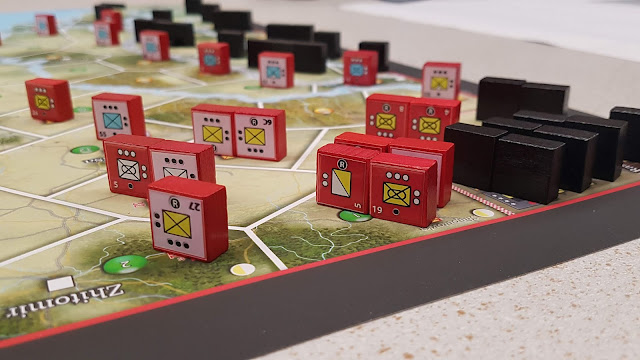1. Les Preludes - July 1941
2. The River - August to the end of September 1941
3. The Pocket - September to the end of October 1941
4. The Snow - November to the end of December 1941
5. The Southern Struggle Campaign Game - July to the end of
December 1941
2. 1 Rules manual
3. 2 rules Summary and Player's Aids
4. 151 PVC Stickers
5. 2 Orders of Battle/Scenario Setup Aids
6. 56 Wooden Markers: 1 Weather Forecast Marker (yellow
cylinder); 1 Initiative Disc (large green disc); 2 Weather
Markers (white discs); 4 Soviet Supply and Control Discs
(1 yellow, 1 orange, 1 light blue, 1 blue); 13 Artillery Fire
Markers(squares, 2 blue, 4 black, and 7 red); 20 Area
Control Markers (cubes, 10 red, 10 black); 5 River
Crossing Markers (blue cubes); 10 Out of Supply Markers
(white cubes);
7. 112 wooden Block Counter Units (black, blue, brown, green,
tan, and red blocks)
8. 8 Luftwaffe Bombers (8 black discs)
9. 2 Soviet Fleets (red plates)
10. 4 Dice
Map: 1:1,000,000 (1cm = 10Km)
Players: 2 Players, with excellent solitaire suitability
Sequence of Play
1. Logistics Phase (2,3,4,5, and 6 turn)
2. Impulse Phase (player with the initiative first)
Bad weather Check (2nd impulse of October)
Supply Check (always)
HQ Activation Segment (TI only)
Command Segment (always)
Combat Segment (TI and SI only)
Blitz Segment (TI only)
HQ Deactivation Segment (TI only)
Isolation Check (always)
Exploitation (playing the Initiative Disc after a TI)
3. Final Phase
I will use their own words to describe a turn:
"A Turn is made up of a variable number of Impulses, from a minimum of two, up to unlimited. When a new Turn starts, the player with the Initiative plays the 1st impulse, followed by the other player, and so on.
A player may:
a. play a Strategic Impulse (SI) or
b. play a Tactical Impulse (TI) or
c. Pass
After two consecutive Passes (by the two players. one per player), the Turn ends and a new one begins."
And the verdict is (drum roll please), another winner from VentoNuovo Games. This game, while using the mechanics of its older siblings, is in most ways a lot tougher nut to crack, at least in the beginning. The player will get to see exactly what Amy Group South was up against during Barbarossa. The components are second to none (especially if you avail yourself of the more expensive options). The gameplay is as usual a winner (when you have a winning combination, why change it). The addition of all of the randomness in the games, as mentioned, lead to each game being different. It also lends itself to solitaire play. This is a great selling point in this day and age. Thank you VentoNuovo for allowing me to review this game. Owners of the first two in the Barbarossa trilogy will be pleased to know that work is being done to make all three playable together. What a monster that will be!
My reviews of the other two games in the trilogy:
https://www.awargamersneedfulthings.co.uk/2018/07/moscow-41-by-vento-nuovo-games.html
https://www.awargamersneedfulthings.co.uk/2019/08/leningrad-41-by-ventonuovo-games.html













































Follow Us